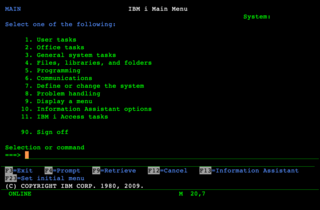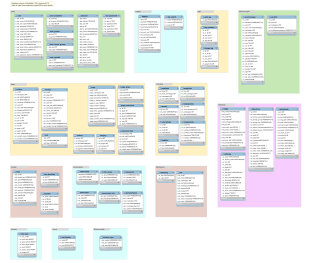Related Research Articles

In computing, a database is an organized collection of data stored and accessed electronically. Small databases can be stored on a file system, while large databases are hosted on computer clusters or cloud storage. The design of databases spans formal techniques and practical considerations, including data modeling, efficient data representation and storage, query languages, security and privacy of sensitive data, and distributed computing issues, including supporting concurrent access and fault tolerance.

An object database or object-oriented database is a database management system in which information is represented in the form of objects as used in object-oriented programming. Object databases are different from relational databases which are table-oriented. A third type, object–relational databases, is a hybrid of both approaches.
A relational database is a database based on the relational model of data, as proposed by E. F. Codd in 1970. A system used to maintain relational databases is a relational database management system (RDBMS). Many relational database systems are equipped with the option of using SQL for querying and updating the database.
Structured Query Language, abbreviated as SQL, is a domain-specific language used in programming and designed for managing data held in a relational database management system (RDBMS), or for stream processing in a relational data stream management system (RDSMS). It is particularly useful in handling structured data, i.e. data incorporating relations among entities and variables.

VSEn is an operating system for IBM mainframe computers, the latest one in the DOS/360 lineage, which originated in 1965.

An object–relational database (ORD), or object–relational database management system (ORDBMS), is a database management system (DBMS) similar to a relational database, but with an object-oriented database model: objects, classes and inheritance are directly supported in database schemas and in the query language. In addition, just as with pure relational systems, it supports extension of the data model with custom data types and methods.

Db2 is a family of data management products, including database servers, developed by IBM. It initially supported the relational model, but was extended to support object–relational features and non-relational structures like JSON and XML. The brand name was originally styled as DB/2, then DB2 until 2017 and finally changed to its present form.
dBase was one of the first database management systems for microcomputers and the most successful in its day. The dBase system includes the core database engine, a query system, a forms engine, and a programming language that ties all of these components together. dBase's underlying file format, the .dbf file, is widely used in applications needing a simple format to store structured data.

IBM i is an operating system developed by IBM for IBM Power Systems. It was originally released in 1988 as OS/400, as the sole operating system of the IBM AS/400 line of systems. It was renamed to i5/OS in 2004, before being renamed a second time to IBM i in 2008. It is an evolution of the System/38 CPF operating system, with compatibility layers for System/36 SSP and AIX applications. It inherits a number of distinctive features from the System/38 platform, including the Machine Interface, the implementation of object-based addressing on top of a single-level store, and the tight integration of a relational database into the operating system.
Oracle Database is a multi-model database management system produced and marketed by Oracle Corporation.
Adabas, a contraction of “adaptable database system," is a database package that was developed by Software AG to run on IBM mainframes. It was launched in 1971 as a non-relational database. As of 2019, Adabas is marketed for use on a wider range of platforms, including Linux, Unix, and Windows.
IBM System R is a database system built as a research project at IBM's San Jose Research Laboratory beginning in 1974. System R was a seminal project: it was the first implementation of SQL, which has since become the standard relational data query language. It was also the first system to demonstrate that a relational database management system could provide good transaction processing performance. Design decisions in System R, as well as some fundamental algorithm choices, influenced many later relational systems.
A database server is a server which uses a database application that provides database services to other computer programs or to computers, as defined by the client–server model. Database management systems (DBMSs) frequently provide database-server functionality, and some database management systems rely exclusively on the client–server model for database access.
Cincom Systems, Inc., is a privately held multinational computer technology corporation founded in 1968 by Tom Nies, Tom Richley, and Claude Bogardus.
IBM Spectrum Protect is a data protection platform that gives enterprises a single point of control and administration for backup and recovery. It is the flagship product in the IBM Spectrum Protect family.
In computing, Advanced Program to Program Communication or APPC is a protocol which computer programs can use to communicate over a network. APPC is at the application layer in the OSI model, it enables communications between programs on different computers, from portables and workstations to midrange and host computers. APPC is defined as VTAM LU 6.2
In IBM System z9 and successor mainframes, the System z Integrated Information Processor (zIIP) is a special purpose processor. It was initially introduced to relieve the general mainframe central processors (CPs) of specific Db2 processing loads, but currently is used to offload other z/OS workloads as described below. The idea originated with previous special purpose processors, the zAAP, which offloads Java processing, and the IFL, which runs Linux and z/VM but not other IBM operating systems such as z/OS, DOS/VSE and TPF. A System z PU is "characterized" as one of these processor types, or as a CP, or SAP. These processors do not contain microcode or hardware features that accelerate their designated workloads. Instead, by relieving the general CP of particular workloads, they often lead to a higher workload throughput at reduced license fees.

A database model is a type of data model that determines the logical structure of a database. It fundamentally determines in which manner data can be stored, organized and manipulated. The most popular example of a database model is the relational model, which uses a table-based format.

Britton Lee Inc. was a pioneering relational database company. Renamed ShareBase, it was acquired by Teradata in June, 1990.

Distributed Data Management Architecture (DDM) is IBM's open, published software architecture for creating, managing and accessing data on a remote computer. DDM was initially designed to support record-oriented files; it was extended to support hierarchical directories, stream-oriented files, queues, and system command processing; it was further extended to be the base of IBM's Distributed Relational Database Architecture (DRDA); and finally, it was extended to support data description and conversion. Defined in the period from 1980 to 1993, DDM specifies necessary components, messages, and protocols, all based on the principles of object-orientation. DDM is not, in itself, a piece of software; the implementation of DDM takes the form of client and server products. As an open architecture, products can implement subsets of DDM architecture and products can extend DDM to meet additional requirements. Taken together, DDM products implement a distributed file system.
References
- ↑ "SQL/DS". encyclopedia.com .
- ↑ "SQL/DS Version 3 Release 5".
- ↑ S. Sumathi, S. Esakkirajan (13 Feb 2007). Fundamentals of Relational Database Management Systems. Springer. ISBN 978-3540483977.
The product was called SQL/DS (Structured Query Language/Data Store) and ran under the DOS/VSE operating system environment
- ↑ Hershel Harris (2013). "SQL/DS: IBM's First RDBMS". IEEE Annals of the History of Computing. 35 (2): 69–71. doi:10.1109/MAHC.2013.28. S2CID 28190519.
- ↑ "DB2 Connect User's Guide".
- ↑ "NATURAL 2/SQL-DS, NATURAL 2/DB2". Computerworld . October 26, 1987.
- ↑ "Natural for SQL/DS".